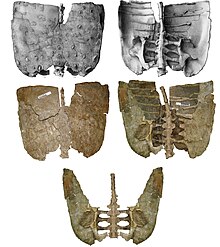| Polacanthines Temporal range: Late Jurassic - Late Cretaceous,
| |
|---|---|

| |
| Pelvis of Polacanthus | |
| Scientific classification | |
| Domain: | Eukaryota |
| Kingdom: | Animalia |
| Phylum: | Chordata |
| Clade: | Dinosauria |
| Clade: | †Ornithischia |
| Clade: | †Thyreophora |
| Clade: | †Ankylosauria |
| Family: | †Nodosauridae |
| Subfamily: | †Polacanthinae Lapparent & Lavocat, 1955 |
| Genera | |
| Synonyms[1] | |
| |
Polacanthinae is a subfamily of ankylosaurs, most often nodosaurids, from the Late Jurassic through Early Cretaceous of Europe and potentially North America and Asia. The group is defined as the largest clade closer to Polacanthus foxii than Nodosaurus textilis or Ankylosaurus magniventris, as long as that group nests within either Nodosauridae or Ankylosauridae. If Polacanthus, and by extent Polacanthinae, falls outside either family-level clade, then the -inae suffix would be inappropriate, and the proper name for the group would be the informally defined Polacanthidae.[1]
Polacanthines were somewhat more lightly armoured than more advanced ankylosaurids and nodosaurids. Their spikes were made up of thin, compact bone with less reinforcing collagen than in the heavily armoured nodosaurids. The relative fragility of polacanthine armour suggests that it may have been as much for display as defense.[2] They appear to have become extinct about the same time a land bridge opened between Asia and North America.[3]
- ^ a b Madzia, D.; Arbour, V.M.; Boyd, C.A.; Farke, A.A.; Cruzado-Caballero, P.; Evans, D.C. (2021). "The phylogenetic nomenclature of ornithischian dinosaurs". PeerJ. 9: e12362. doi:10.7717/peerj.12362. PMC 8667728. PMID 34966571.
- ^ Hayashi, S.; Carpenter, K.; Scheyer, T.M.; Watabe, M.; Suzuki, D. (2010). "Function and evolution of ankylosaur dermal armor" (PDF). Acta Palaeontologica Polonica. 55 (2): 213–228. doi:10.4202/app.2009.0103.
- ^ Kirkland, J. I. (1996). Biogeography of western North America's mid-Cretaceous faunas - losing European ties and the first great Asian-North American interchange. J. Vertebr. Paleontol. 16 (Suppl. to 3): 45A.